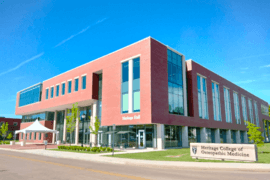Heritage College of Osteopathic Medicine facts for kids
 |
|
| Type | Public |
|---|---|
| Established | 1975 |
| Endowment | $18.0 million |
| Budget | $105 million |
| Dean | Kenneth H. Johnson, D.O. |
|
Academic staff
|
142 |
| 1,001 | |
| Location |
,
U.S.
39°20′16″N 82°05′44″W / 39.3379°N 82.0956°W |
| Campus | Rural, urban |
| Mascot | Ostie the Osteopathic Owl and Rufus the Bobcat |
 |
|
| https://www.ohio.edu/medicine/about/who-we-are/facts | |
The Heritage College of Osteopathic Medicine (often called OU-HCOM) is a special medical school at Ohio University. It's the biggest medical school in Ohio and the only one that teaches osteopathic medicine. This college is known for being one of the top 50 medical schools in the U.S. for training doctors who focus on primary care, which means they are often your first stop when you need a doctor.
Contents
What Heritage College Does
The main goal of Heritage College is to teach future physicians (doctors) to work in primary care. They especially want to help people in areas of Ohio that don't have enough doctors, like Appalachian and city areas. The college offers a main program where students earn a Doctor of Osteopathic Medicine (D.O.) degree. They also have programs where you can earn two degrees at once. Doctors who graduate from Heritage College can work in all 50 U.S. states and over 50 other countries.
Helping the Community
The Heritage College helps the community a lot. For example, its health services and clinics bring in about $63 million in benefits to Southeast Ohio. Many of these health services are even free for people. This shows how much the college helps the health and economy of the area.
History of the College
The idea for a medical school at Ohio University started way back in 1823. But it wasn't until 1975 that the Heritage College was officially created. Its first class had 21 graduates who earned the Doctor of Osteopathic Medicine (D.O.) degree. The college has grown a lot since then. In the 2023-2024 school year, there were 1,001 students studying there.
Important Discoveries
In 1989, a scientist named John Kopchick, who worked at Heritage College, made a big discovery. He found a special compound that later became a medicine called Pegvisomant (Somavert). This medicine helps treat a condition called acromegaly, which is when the body makes too much growth hormone. Dr. Kopchick's discovery earned Ohio University a lot of money, which helped the university grow.
A Historic Dean
In 1993, Barbara Ross-Lee, D.O., became the dean of the Heritage College. This was a very important moment because she was the first African-American woman to lead a medical school in the United States.
Growing with New Campuses
In 2011, the Heritage College received a huge gift of $105 million. This was the biggest private gift ever given to Ohio University! With this money, the college started building two new campuses. One was in Dublin, Ohio, working with OhioHealth. The other was in Cleveland, Ohio, working with Cleveland Clinic. The Dublin campus welcomed its first 50 students in July 2014. The Cleveland campus started classes in July 2015 with its first 50 students.
College Locations
The main campus of Heritage College is in Athens, Ohio, on the main Ohio University campus. A new building called Heritage Hall opened in 2021. In 2023, the college received another $70 million to build an even bigger hall next door for practice. The Athens campus is close to OhioHealth O'Bleness Hospital, where students can get real-world experience.
Besides Athens, the Heritage College has two other campuses:
- In Dublin, Ohio, which has both an extension campus and a medical campus.
- In Cleveland, Ohio, which works closely with the Cleveland Clinic.
Becoming a Student
Heritage College is known as one of the top 50 U.S. medical schools for primary care. It's also the largest medical school in Ohio. In the fall of 2023, there were 1,001 students across all three campuses: 473 in Athens, 245 in Cleveland, and 283 in Dublin. Getting into the college is competitive, and they look at many different things about each applicant. Since it's a state-funded school, they often prefer students who live in Ohio.
For students who started in 2022, the average grades were high, and the average MCAT score (a test for medical school) was around 504.50. For the class that started in 2023, the average overall GPA was 3.66, and the average MCAT score was 503.44. Out of almost 5,000 applicants, 260 students were accepted into the class of 2027.
How Students Learn
Medical students at Heritage College can choose from two main ways of learning during their first two years. One way, called the Clinical Presentation Continuum (CPC), focuses on lectures and discussions about different symptoms. The other way, called the Patient-Centered Continuum (PCC), gives students more time in clinics. Here, they learn how to talk to patients and solve problems. In their third and fourth years, students work in one of 29 teaching hospitals across Ohio. This is part of a special network called the Centers for Osteopathic Research and Education (CORE).
Dual Degree Programs
The college also offers programs where students can earn two degrees at once, like:
- D.O. and a Master of Public Health (M.P.H.)
- D.O. and a Master of Health Administration (M.H.A.)
- D.O. and a Master of Business Administration (M.B.A.)
- D.O. and a Ph.D.
Important People
Deans of the College
- Kenneth H. Johnson, D.O. — 2012–present
- John "Jack" Adolph Brose, D.O. — 2001–2012
- Daniel Jon Marazon, D.O. — 2001
- Barbara Ross-Lee, D.O. — 1993–2000
- Frank Wayne Myers, D.O. — 1977–1993
- Gerald Alden Faverman, Ph.D. — 1975–1977
Famous Alumni
- Robert Biscup, D.O. '80
- Terry Johnson (Ohio politician), D.O. '91
- Thomas Hutson, D.O. '97
Notable Faculty
- John Kopchick, Ph.D.
See also
- OhioHealth
- Cleveland Clinic
- History of Ohio University
- List of Medical Schools in the United States
- Ohio University Russ College of Engineering and Technology


